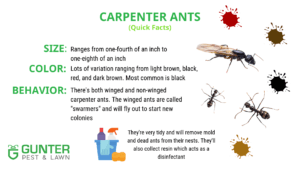Ants are basically everywhere… This includes Kansas city! Whether you’ve been living here for years or are a recent Kansas City resident, I’m sure you’ve noticed ants in your home at some point or another and are looking for your own personal Kansas City Homeowner’s guide to ants. This time of year it’s especially common for finding these little critters crawling around your home.
Gunter Pest & Lawn’s pest control technicians have over 40+ years of combined experience dealing with ant infestations and we want to share our knowledge with you! We’ll give you a little inside information on these native Kansas City ants and what you can do as a homeowner to try and prevent them from breaking an entry. Ants are no match against a knowledgeable homeowner!
What ant Species are native to Kansas CITY?
Here in the Kansas City area, you’ll find a variety of different ant species. A few of those include Odorous House Ants, Pharaoh Ants, Pavement Ants, Carpenter Ants, Field Ants, Thief Ants, Fire Ants, and Acrobat Ants. Most of these ant types build their colonies underground, serving their queen. Most prefer to nest outdoors, but if the conditions are right, they’ll happily move into your home. As one of the best Kansas City pest control companies, we want to help you figure out what kind of ant issue or ant problem you’re dealing with and how to get rid of it.
Types Of Ants In Kansas City, Missouri
Odorous House Ants
This pesky ant species can be very difficult to control. They form enormous colonies with multiple queens. Often times homeowners or inexperienced ant control companies (Pest Control) will kill one of the queens thinking that they’ve solved the problem. Little do they know there are multiple other queens popping out more eggs by the second. Odorous house ants also spread quickly putting your neighbors’ properties at risk.
Where To Look
The good news is that these ants prefer to nest outdoors. They’ll often create colonies within landscape mulch, beneath loose bark on trees, under ground cover, in potted plants, and within piles of items such as lumber, firewood, or bricks. Although they prefer the great outdoors, they will sometimes establish nests inside homes, in walls, beneath carpeting, and in other similar spaces.
Tips From The Experts
As mentioned above, Odorous House Ants can be tricky to get rid of due to the size of their colony. The first thing you’ll want to do is get rid of ideal nesting spots such as piles of lumber, mulch, bricks or other debris. You also want to keep your home as free of moisture as possible. A lot of homeowners make the mistake of setting up their sprinkler system too close to the foundation of their home. This creates the perfect environment for a new ant colony. Even if you take every precaution in the book, they may still find a way into your home. If this happens, call your local pest control company immediately before the colony grows.
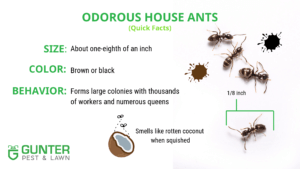
Pharaoh Ants
This type of ant is another tricky ant problem to eradicate. When the colony feels threatened, it will split into various other colonies in order to guarantee its survival. It’s important to kill every ant in the colony, especially their queen when trying to get rid of them.
Where To Look
Pharaoh ants love damp spaces. They’re known for establishing colonies in moisture-rich locations within your home such as your kitchen, bathroom, or basement. You may notice them in other parts of your house as well since they often travel from room to room via plumbing pipes and electrical wires.
Tips From The Experts
Unfortunately, the only true way to control a Pharaoh ant infestation is by strategically placing ant baits around your home. It’s important to use the right kind of bait. This can vary depending on the type and size of the colony you’re dealing with. If Pharaoh ants have inhabited your home, your best bet for getting rid of them is to call an experienced exterminator.
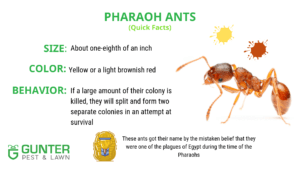
Pavement Ants
These ants are the ones you’ll most commonly find in and around sidewalks and driveways. Their nests were most likely the ones you spent the most time destroying during your childhood. These guys have a sweet tooth as well but will resort to other tidbits if need be. They’re not too picky.
Where To Look
You’ll most commonly find them nesting underneath slabs of concrete, driveways, patios, and decks. Their nests are pretty easy to spot since they create those cliche ant hills we know and don’t exactly love. The most common place you’ll find them in your home is around the foundation. Sometimes they’ll venture up into the walls by carrying soil to make a nest.
Tips From The Experts
A single colony can usually be dealt with by using ant baits which you can purchase and use yourself. We still highly recommend contacting a pest control company for foundation and perimeter inspection to ensure long-term eradication. A surface-level treatment will usually do the trick, but on occasion a deeper level of treatment is necessary. In order to carry out those deep treatments, the pavement must be drilled through and removed. Or Kansas City homeowner’s guide to ants is helpful with pavement ants.
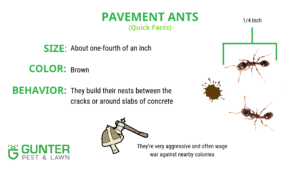
Carpenter Ants
These ants are the most common of all the ants found in homes across the midwest. They’re the ones you usually find crawling across your kitchen floor or crashing your picnic. Carpenter Ants are also the ones who are regularly referred to as “mighty ants” since they can lift seven times their own body weight with just their teeth. That’s quite the superpower!
Where To Look
Carpenter Ants, similar to some of the other ant species mentioned above, love to nest in damp spaces. These ants require a constant source of moisture to survive. If they do decide to move their nest indoors, you’ll most commonly find them around plumbing, in hollow voids, and in poorly ventilated attics and basements. They create “trunk trails” (most commonly found on trees) from their main colony to their satellite colonies. You can find them during the day, although they’re the most active at night.
Tips From The Experts
Treating Carpenter Ants is not an easy task… You have to find and treat all satellite colonies, outdoor colonies, and the parent colony to completely rid yourself of them. Locating the parent colony can be especially tricky since it could be established in a tree or a neighbor’s property. Even when you do finally locate the parent colony, getting rid of it is easier said than done. The Carpenter Ant bait that most pest experts use can have varying effects due to carpenter ant’s picky eating habits. If you’re dealing with this species of ant, we highly recommend investing in routine treatments in order to fully eradicate all colonies and prevent the problem from arising again.
Field Ants
Field ants are one of the most diverse types of ants with over 150 species worldwide. They’re commonly mistaken for both Carpenter Ants (due to their size and shape) and Fire Ants (due to their painful bite). These ants are usually the least threatening since they rarely venture indoors.
Where To Look
Field Ants are most commonly found in fields, forests, yards, gardens, and landscaping. These ants truly have a love for the outdoors and will very rarely invade your home. You may see them crawling around your porch or foundation and if you think you see them in your home, you may be mistaking them for a Carpenter Ant.
Tips From The Experts
Field Ants build large nests that can be up to a foot in diameter. They’re another species that construct ant hills so their nests are also hard to miss. Although these ants won’t inhabit your home, they will inhabit your lawn and can cause a lot of damage. If you notice a large anthill on your lawn, we recommend treating it right away before the issue spreads.
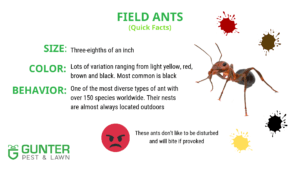
Thief Ants
This ant species is one of the smallest found in the Midwest. These sneaky ants get their name due to their habit of stealing food from other ant colonies. They’ll even eat the larvae of other ants! They may be small, but they are ruthless. Their colonies, like the ants themselves, are very small and hard to spot.
Where To Look
They’re not too picky as to where they establish their nests. They’ll nest in soil, woodpiles, cracks and crevices, concrete, and unfortunately your home. You’ll most likely spot a trail of these little guys in your bathroom, kitchen, or around windows and doorways.
Tips From The Experts
These ants are very difficult to get rid of due to the size of their nests. You can try to locate the nest yourself, but we recommend reaching out to a professional ant exterminator. They’ll know exactly where to look and how to eliminate the problem. Thief Ants can often be mistaken for Pharaoh Ants since they’re similar in color. Homeowners will often use Pharaoh Ant treatments thinking that it will solve the problem. The two ant species prefer different food types so the treatments for these two species aren’t interchangeable.
**Not as commonly found in the Kansas City area
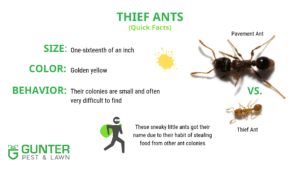
Acrobat Ants
Acrobat Ants are named after their tendency to wave their thorax above their heads when threatened. These ants are very adventurous and will go to great lengths to bring back a tasty treat for their queen. They establish well-defined trails from food and water sources to the nest, therefore they’re a bit easier to get rid of due to their predictability.
Where To Look
These ants prefer to nest outside in rotting wood or gardens. Most infestations start outdoors but may move indoors if you have a lot of rotting wood in your foundation due to water leaks. Once they set up nest indoors, you may start to notice them poking about your kitchen looking for a sweet snack.
Tips From The Experts
The best way to get rid of Acrobat Ants is to inspect and treat all areas where there is any form of moist material or rotting wood. You’ll also want to fix all water leaks in your home and trim trees and hedges so that they aren’t touching your house, if possible.
**Not as commonly found in the Kansas City area. Use our Kansas City homeowner’s guide to ants for help.
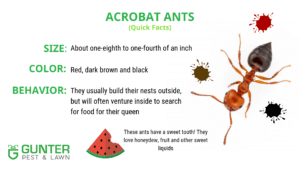
Frequently Asked Questions About Ants
Q: Do grasshoppers eat ants?
A: Grasshoppers are herbivorous insects, primarily feeding on plant matter such as leaves, grass, and other vegetation. While they are not known to actively hunt and consume ants, in some cases, they may inadvertently ingest ants while feeding on plants. However, it’s not a typical part of their diet, and grasshoppers are not considered natural predators of ants.
Q: What do ant eggs look like?
A: Ant eggs vary in appearance depending on the species, but they are generally small, oval-shaped, and translucent. They are typically white or cream-colored and can be difficult to spot due to their size and the location of ant colonies, which are often hidden in soil, leaf litter, or other secluded areas. Ant eggs are laid by the queen ant and are tended to by worker ants until they hatch into larvae.
Q: What attracts carpenter ants?
A: Carpenter ants are attracted to both food sources and nesting sites. They are particularly drawn to moist or decaying wood, which they excavate to create their nests. Carpenter ants also forage for food indoors, seeking out sweet or protein-based foods such as sugary drinks, fruit, meat, and pet food. Additionally, they may be attracted to homes with high levels of moisture or wood that has been damaged by water, as these conditions provide suitable nesting sites.
Q: What essential oils do ants hate?
A: Several essential oils are believed to repel ants due to their strong scents and potential insecticidal properties. Some essential oils that ants may dislike include:
- Peppermint oil
- Tea tree oil
- Lemon oil
- Eucalyptus oil
- Citronella oil
These essential oils can be diluted in water and sprayed around entry points or areas where ants are present to deter them from entering. However, it’s important to note that while essential oils may help repel ants, they may not provide complete eradication of an ant infestation, especially in severe cases.
Q: Can you vacuum ants?
A: Yes, you can vacuum ants as a temporary means of pest control. Using a vacuum cleaner with a hose attachment, you can remove ants from surfaces such as floors, countertops, and windowsills. However, it’s important to empty the vacuum bag or canister promptly after vacuuming ants to prevent them from escaping and potentially reinfesting your home. Additionally, vacuuming alone may not solve an ant infestation problem, so it’s advisable to use other methods in conjunction with vacuuming, such as cleaning with soapy water, sealing entry points, and using ant baits or repellents.
Q: Can Vinegar Kill Ants?
A: Yes, vinegar can be an effective natural remedy for dealing with ants. Its acidic nature disrupts the ants’ scent trails, making it difficult for them to navigate and communicate with each other, ultimately leading them away from your home.
Q: Do Ants Carry Diseases?
A: Yes, although the risk is generally low compared to other pests, ants can carry and transmit diseases. While they are more commonly associated with contaminating food, they can still pose health risks.
Q: When Are Ants Most Active?
A: Ant activity levels can vary depending on factors such as species, environmental conditions, and food availability. However, in general, ants tend to be most active during warmer months, particularly in spring and summer when temperatures are favorable for foraging and colony expansion.

